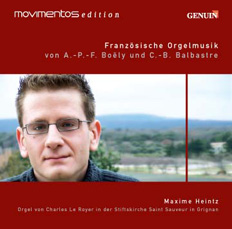French Organ Music
Works by A.-P.-F. Boely and C.-B. Balbastre
Edition Movimentos
Tracklist
- Alexandre-Pierre-Francois Boely (1785-1858)
Andante con moto - Alexandre-Pierre-Francois Boely (1785-1858)
Allegro ma non troppo, f-Moll - Alexandre-Pierre-Francois Boely (1785-1858)
Allegretto, h-Moll - Alexandre-Pierre-Francois Boely (1785-1858)
Canone all'octava, e-Moll - Alexandre-Pierre-Francois Boely (1785-1858)
Fantaisie et Fugue, B-Dur - Claude-Benigne Balbastre (1724-1799)
Prélude et Rondo, C-Dur - Claude-Benigne Balbastre (1724-1799)
Pièce sans Titre, B-Dur - Claude-Benigne Balbastre (1724-1799)
Prélude, D-Dur - Claude-Benigne Balbastre (1724-1799)
Duo, D-Dur - Claude-Benigne Balbastre (1724-1799)
Noel, A-Dur - Claude-Benigne Balbastre (1724-1799)
Pièce sans Titre, C-Dur - Claude-Benigne Balbastre (1724-1799)
Pièce sans Titre, D-Dur - Claude-Benigne Balbastre (1724-1799)
Cannonade, D-Dur - Claude-Benigne Balbastre (1724-1799)
Carillon des Morts, F-Dur - Claude-Benigne Balbastre (1724-1799)
Marche des Marseillois et l'Air Ca-ira, C-Dur
Does your CD collection include organ music by Balbastre and Boëly? If your answer is “not a single disc,” you are no different than most of us. This is no cause for concern, for things can be set right. Adding a Genuin recording of organ works by these French masters will be generously rewarded. On his most recent disc, French organist Maxime Heintz has recorded works by the venerated Claude Balbastre (1724-1799) and Alexandre Pierre François Boëly (1785-1858). Performing on “his” restored period organ in Grignan in the south of France, Heintz convincingly demonstrates the high merit of this rarely heard repertoire. Technically brilliant, evocative and playful Classical music by the keyboard virtuoso Balbastre and the drawn out lines of harmonically exquisite, perfectly proportioned Romantic sound by the great pedagogue Boëly—this is organ literature at its finest.
"And one must indeed treat him [Claude-Bénigne Balbastre] with the respect shown him by the young organist Maxime Heintz if one wishes to do justice to his significance. Heintz performs with intelligence and joy on the organ of the Collegiate Church Saint-Sauveur de Grignan. It is around this 17th-century core that all the following centuries have formed layers – not to the detriment of the sonic expression, as Heintz makes us aware with each note."
(Fono Forum 7/2009)
"From astonishing to breathtaking!" (Organ 2/2009)










